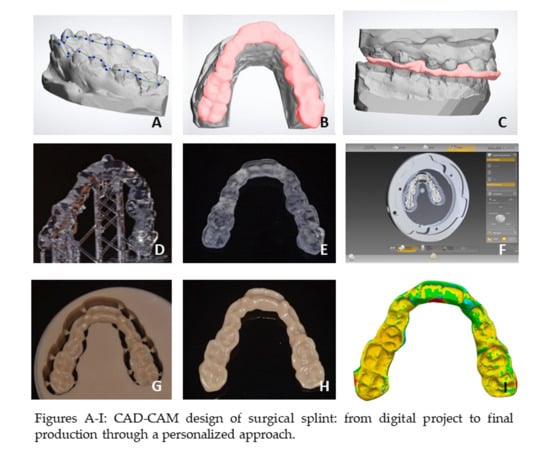Comparison between Additive and Subtractive CAD-CAM Technique to Produce Orthognathic Surgical Splints: A Personalized Approach
Abstract
1. Introduction
2. Materials and Methods
Statistical Analysis
3. Results
4. Discussion
Study Limitations
5. Conclusions
Author Contributions
Funding
Conflicts of Interest
References
- Eckhardt, A.B.; Cunningham, S.J. How predictable is orthognathic surgery? Eur. J. Orthod. 2004, 26, 303–309. [Google Scholar] [CrossRef] [PubMed]
- Ellis, E., III. Bimaxillary surgery using an intermediate splint to position the maxilla. J. Oral Maxillofac. Surg. 1999, 57, 53–56. [Google Scholar] [CrossRef]
- Metzger, M.C.; Hohlweg-Majert, B.; Schwarz, U.; Teschner, M.; Hammer, B.; Schmelzeisen, R. Manufacturing splints for orthognathic surgery using a three-dimensional printer. Oral Surg. Oral Med. Oral Pathol. Oral Radiol. 2008, 105, e1–e7. [Google Scholar] [CrossRef]
- Gateno, J.; Xia, J.; Teichgraeber, J.F.; Rosen, A.; Hultgren, B.; Vadnais, T. The precision of computer-generated surgical splints. J. Oral Maxillofac. Surg. 2003, 61, 814–817. [Google Scholar] [CrossRef]
- Swennen, G.R.; Mommaerts, M.; Abeloos, J.; De Clercq, C.; Lamoral, P.; Neyt, N.; Casselman, J.; Schutyser, F. A cone-beam CT based technique to augment the 3D virtual skull model with a detailed dental surface. Int. J. Oral Maxillofac. Surg. 2009, 38, 48e–57e. [Google Scholar] [CrossRef]
- Zinser, M.J.; Mischkowski, R.A.; Sailer, H.F.; Zoller, J.E. Computer-assisted orthognathic surgery: Feasibility study using multiple CAD/CAM surgical splints. Oral Surg. Oral Med. Oral Pathol. Oral Radiol. 2012, 113, 673–687. [Google Scholar] [CrossRef] [PubMed]
- Adolphs, N.; Liu, W.; Keeve, E.; Hoffmeister, B. RapidSplint: Virtual splint generation for orthognathic surgery—Results of a pilot series. Comput. Aided Surg. 2014, 19, 20–28. [Google Scholar] [CrossRef] [PubMed]
- Gateno, J.; Xia, J.J.; Teichgraeber, J.F.; Christensen, A.M.; Lemoine, J.J.; Liebschner, M.A.; Gliddon, M.J.; Briggs, M.E. Clinical feasibility of computer-aided surgical simulation (CASS) in the treatment of complex craniomaxillofacial deformities. J. Oral Maxillofac. Surg. 2007, 65, 728e–734e. [Google Scholar] [CrossRef] [PubMed]
- Badiali, G.; Costabile, E.; Lovero, E.; Pironi, M.; Rucci, P.; Marchetti, C.; Bianchi, A. Virtual Orthodontic Surgical Planning to Improve the Accuracy of the Surgery-First Approach: A Prospective Evaluation. J. Oral Maxillofac. Surg. 2019, 77, 2104–2115. [Google Scholar] [CrossRef] [PubMed]
- Elnagar, M.H.; Aronovich, S.; Kusnoto, B. Digital Workflow for Combined Orthodontics and Orthognathic Surgery. Oral Maxillofac. Surg. Clin. N. Am. 2020, 32, 1–14. [Google Scholar] [CrossRef]
- Mercuri, E.; Cassetta, M.; Cavallini, C.; Vicari, D.; Leonardi, R.; Barbato, E. Dental anomalies and clinical features in patients with maxillary canine impaction. Angle Orthod. 2013, 83, 22–28. [Google Scholar] [CrossRef] [PubMed]
- Amanullaha, A.N.M.; Murshiduzzamana, S.T.; Khana, R. Design and Development of a Hybrid Machine combining Rapid Prototyping and CNC Milling Operation. Adv. Mater. Process. Technol. Conf. 2017, 184, 163–170. [Google Scholar]
- Pinheiro Dias Engler, M.L.; Güth, J.F.; Keul, C.; Erdelt, K.; Edelhoff, D.; Liebermann, A. Residual monomer elution from different conventional and CAD/CAM dental polymers during artificial aging. Clin. Oral Investig. 2020, 24, 277–284. [Google Scholar] [CrossRef] [PubMed]
- Shaheen, E.; Sun, Y.; Jacobs, R.; Politis, C. Three-dimensional printed final occlusal splint for orthognathic surgery: Design and validation. Int. J. Oral Maxillofac. Surg. 2017, 46, 67–71. [Google Scholar] [CrossRef]
- Kim, S.Y.; Shin, Y.S.; Jung, H.D.; Hwang, C.J.; Baik, H.S.; Cha, J.Y. Precision and trueness of dental models manufactured with different 3-dimensional printing techniques. Am. J. Orthod. Dentofac. Orthop. 2018, 153, 144–153. [Google Scholar] [CrossRef]
- Miyazawa, K.; Kawaguchi, M.; Tabuchi, M.; Goto, S. Accurate pre-surgical determination for self-drilling miniscrew implant placement using surgical guides and cone-beam computed tomography. Eur. J. Orthod. 2010, 32, 735–740. [Google Scholar] [CrossRef]
- Bover-Ramos, F.; Viña-Almunia, J.; Cervera-Ballester, J.; Peñarrocha-Diago, M.; García-Mira, B. Accuracy of Implant Placement with Computer-Guided Surgery: A Systematic Review and Meta-Analysis Comparing Cadaver, Clinical, and In Vitro Studies. Int. J. Oral Maxillofac. Implant. 2018, 33, 101–115. [Google Scholar] [CrossRef]
- Lo Giudice, A.; Rustico, L.; Caprioglio, A.; Migliorati, M.; Nucera, R. Evaluation of condylar cortical bone thickness in patient groups with different vertical facial dimensions using cone-beam computed tomography. Odontology 2020, 108, 669–675. [Google Scholar] [CrossRef]
- Camardella, L.T.; de Vasconcellos Vilella, O.; Breuning, H. Accuracy of printed dental models made with 2 prototype technologies and different designs of model bases. Am. J. Orthod. Dentofac. Orthop. 2017, 151, 1178–1187. [Google Scholar] [CrossRef]
- Park, M.E.; Shin, S.Y. Three-dimensional comparative study on the accuracy and reproducibility of dental casts fabricated by 3D printers. J. Prosthet. Dent. 2018, 119, e1–e861. [Google Scholar] [CrossRef]
- Kim, S.Y.; Lee, S.H.; Cho, S.K.; Jeong, C.M.; Jeon, Y.C.; Yun, M.J.; Huh, J.B. Comparison of the accuracy of digitally fabricated polyurethane model and conventional gypsum model. J. Adv. Prosthodont. 2014, 6, 1–7. [Google Scholar] [CrossRef] [PubMed][Green Version]
- Imam, H.; Gram, M.; Benetti, A.R.; Gotfredsen, K. Accuracy of stereolithography additive casts used in a digital workflow. J. Prosthet. Dent. 2018, 119, 580–585. [Google Scholar] [CrossRef] [PubMed]
- Koch, G.K.; Gallucci, G.O.; Lee, S.J. Accuracy in the digital workflow: From data acquisition to the digitally milled cast. J. Prosthet. Dent. 2016, 115, 749–754. [Google Scholar] [CrossRef] [PubMed]
- Leonardi, R.; Lo Giudice, A.; Rugeri, M.; Muraglie, S.; Cordasco, G.; Barbato, E. Three-dimensional evaluation on digital casts of maxillary palatal size and morphology in patients with functional posterior crossbite. Eur. J. Orthod. 2018, 40, 556–562. [Google Scholar] [CrossRef] [PubMed]
- Lo Giudice, A.; Ronsivalle, V.; Grippaudo, C.; Lucchese, A.; Muraglie, S.; Lagravère, M.O.; Isola, G. One Step before 3D Printing-Evaluation of Imaging Software Accuracy for 3-Dimensional Analysis of the Mandible: A Comparative Study Using a Surface-to-Surface Matching Technique. Materials 2020, 13, 2798. [Google Scholar] [CrossRef] [PubMed]
- Lo Giudice, A.; Rustico, L.; Ronsivalle, V.; Nicotra, C.; Lagravère, M.; Grippaudo, C. Evaluation of the changes of orbital cavity volume and shape after tooth-borne and bone-borne rapid maxillary expansion (RME). Head Face Med. 2020, 16, 21. [Google Scholar] [CrossRef] [PubMed]
- Leonardi, R.; Muraglie, S.; Bennici, O.; Cavallini, C.; Spampinato, C. Three-dimensional analysis of mandibular functional units in adult patients with unilateral posterior crossbite: A cone beam study with the use of mirroring and surface-to-surface matching techniques. Angle Orthod. 2019, 89, 590–596. [Google Scholar] [CrossRef]
- Lo Giudice, A.; Leonardi, R.; Ronsivalle, V.; Allegrini, S.; Lagravère, M.; Marzo, G.; Isola, G. Evaluation of pulp cavity/chamber changes after tooth-borne and bone-borne rapid maxillary expansion. A CBCT study using surface-based superimposition and deviation analysis. Clin. Oral Investig. 2020, 1–11. [Google Scholar] [CrossRef]
- Lo Giudice, A.; Ortensi, L.; Farronato, M.; Lucchese, A.; Lo Castro, E.; Isola, G. The step further smile virtual planning: Milled versus prototyped mock-ups for the evaluation of the designed smile characteristics. BMC Oral Health 2020, 20, 165. [Google Scholar] [CrossRef]
- Leonardi, R.; Loreto, C.; Talic, N.; Caltabiano, R.; Musumeci, G. Immunolocalization of lubricin in the rat periodontal ligament during experimental tooth movement. Acta Histochem. 2012, 114, 700–704. [Google Scholar] [CrossRef]
- Leonardi, R.; Almeida, L.E.; Trevilatto, P.C.; Loreto, C. Occurrence and regional distribution of TRAIL and DR5 on temporomandibular joint discs: Comparison of disc derangement with and without reduction. Oral Surg. Oral Med. Oral Pathol. Oral Radiol. 2010, 109, 244–251. [Google Scholar] [CrossRef] [PubMed][Green Version]
- Yau, H.T.; Yang, T.J.; Lin, Y.K. Comparison of 3-D printing and 5-axis milling for the production of dental emodels from intra-oral scanning. CAD Appl. 2016, 13, 32–38. [Google Scholar]
- Leonardi, R.M.; Aboulazm, K.; Giudice, A.L.; Ronsivalle, V.; D’Antò, V.; Lagravère, M.; Isola, G. Evaluation of mandibular changes after rapid maxillary expansion: A CBCT study in youngsters with unilateral posterior crossbite using a surface-to-surface matching technique. Clin Oral Investig. 2020. [Google Scholar] [CrossRef] [PubMed]
- Yoo-Geum, J.; Wan-Sun, L.; Kyu-Bok, L. Accuracy evaluation of dental models manufactured by CAD/CAM milling method and 3D printing method. J. Adv. Prosthodont. 2018, 10, 245–251. [Google Scholar]
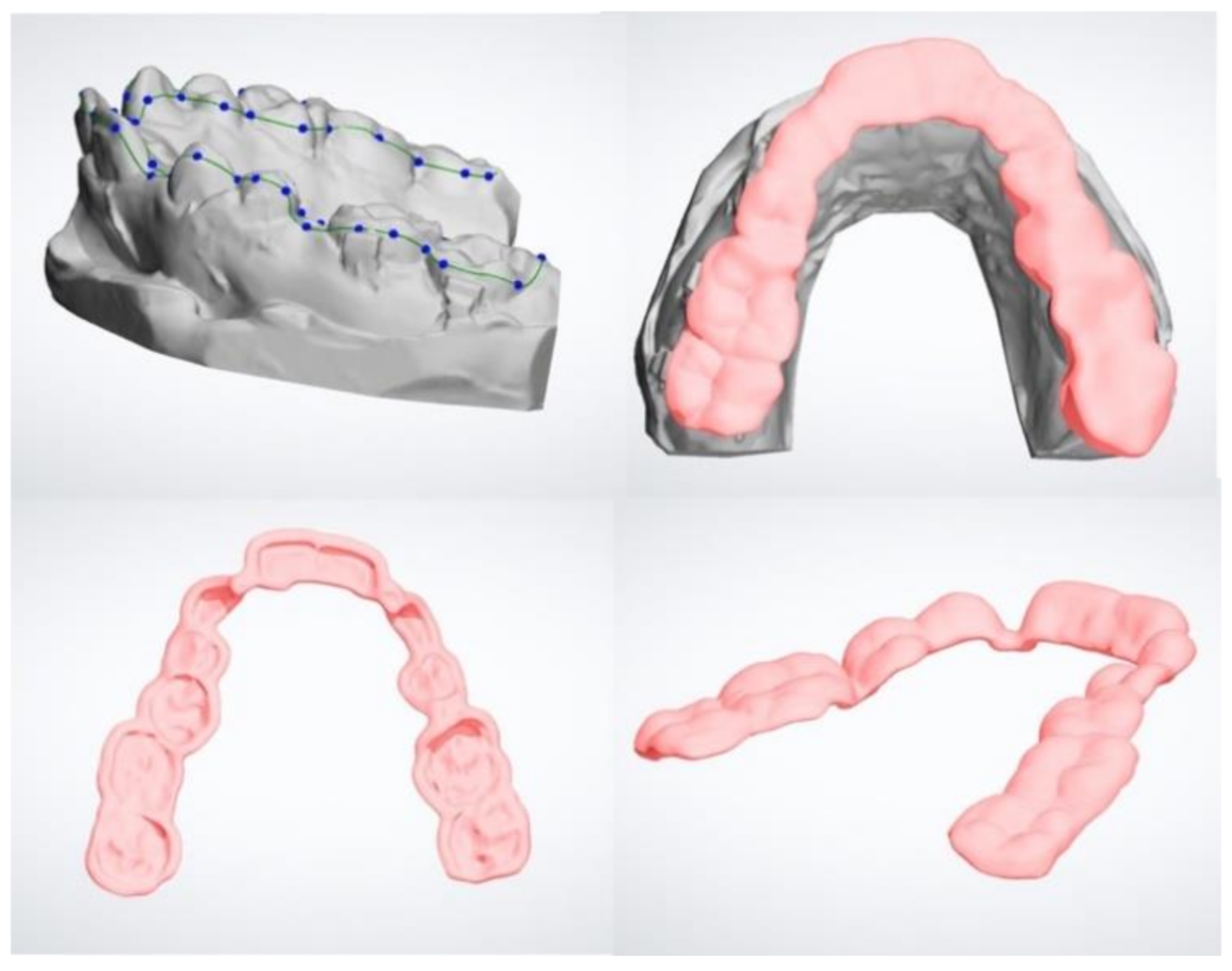
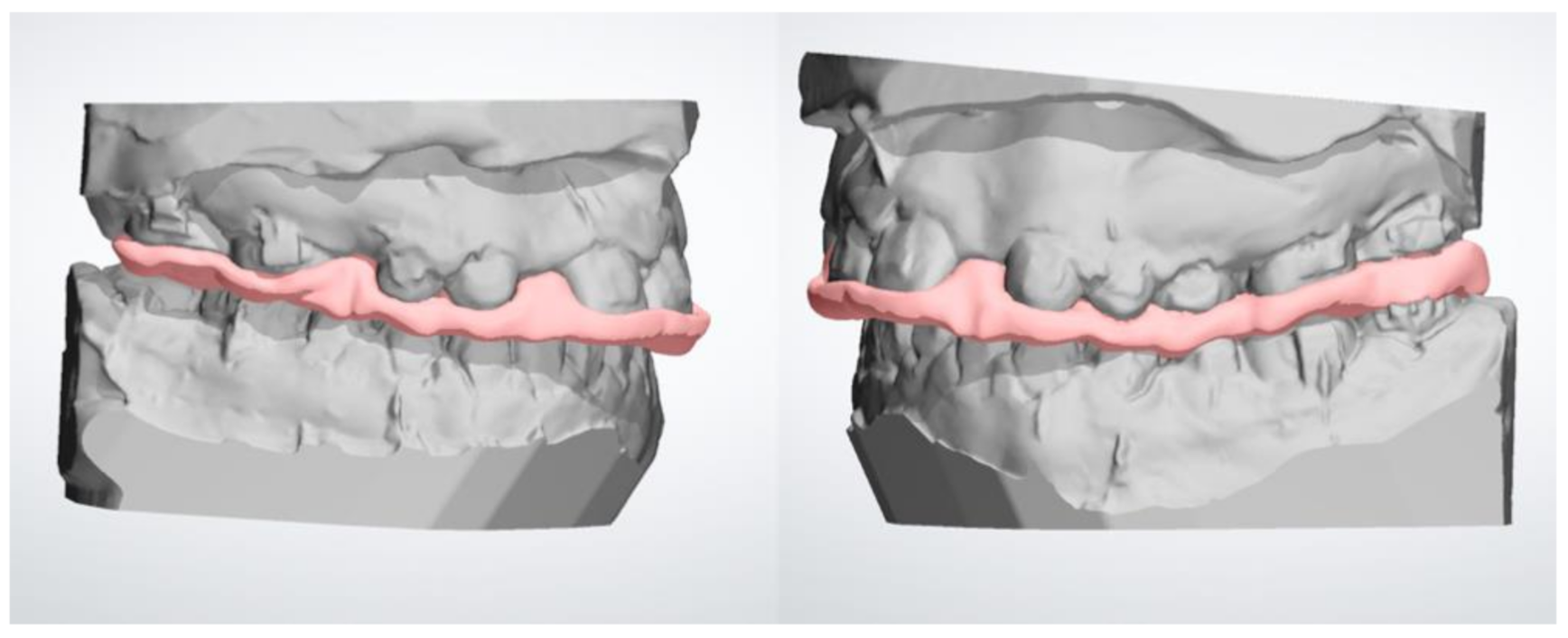

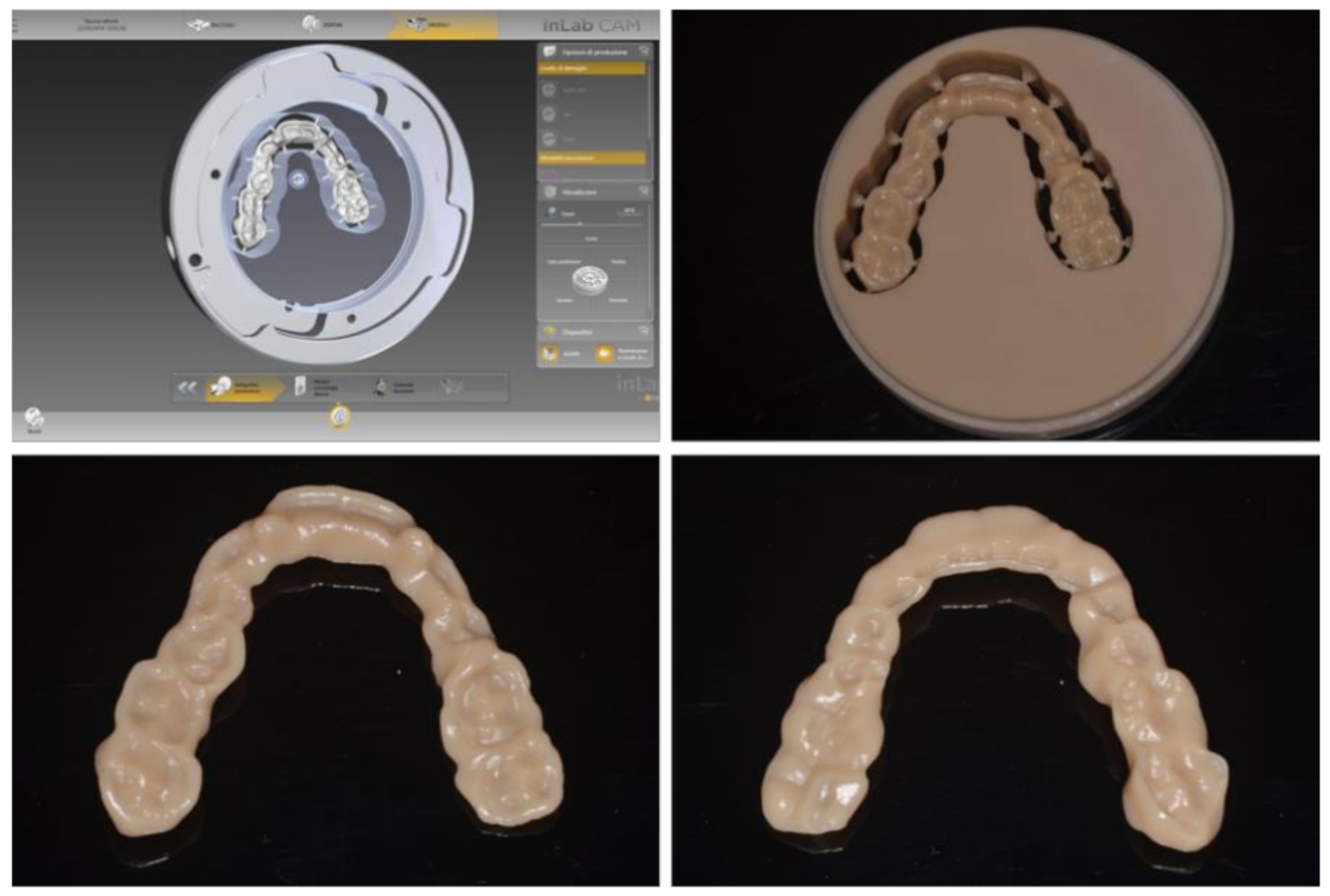
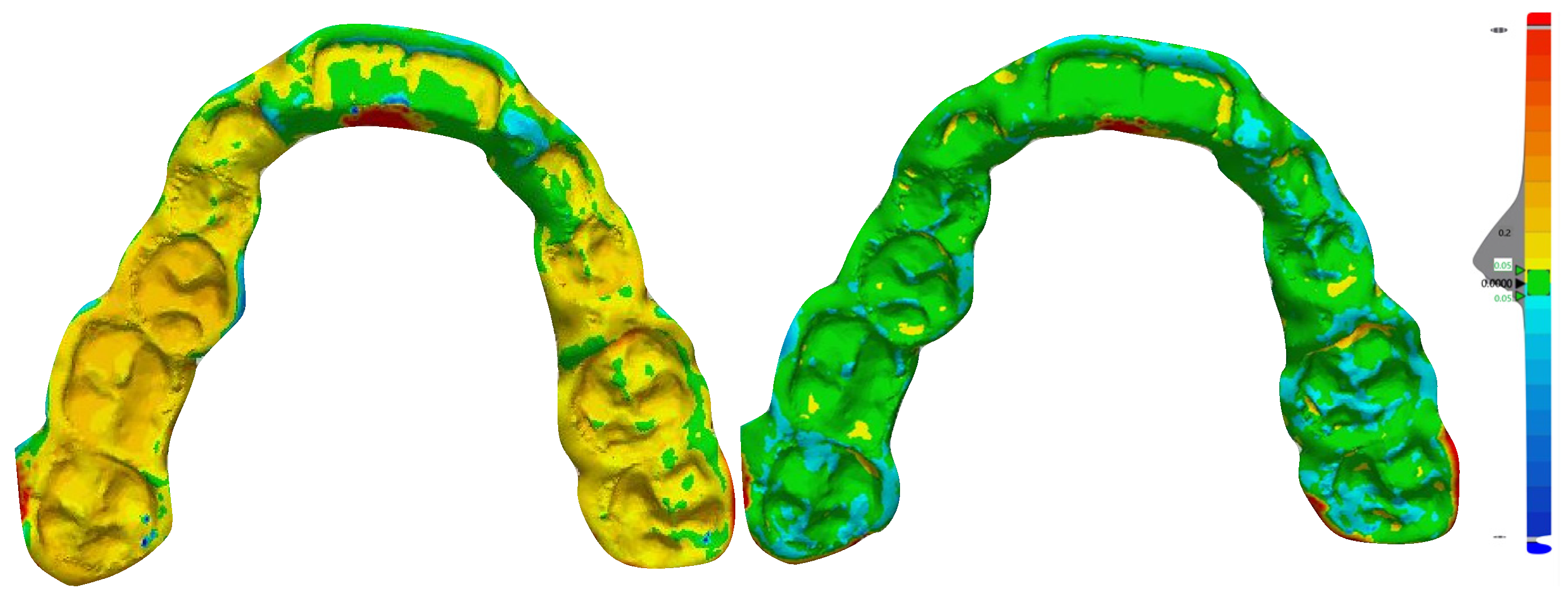
| Matching Percentage | |||
|---|---|---|---|
| Type | n. Total | Mean ±SD | Significance (p) |
| Prototyped | 10 | 0.20 mm ± 0.018 | p < 0.001 |
| Milled | 10 | 0.31 mm ± 0.021 | |
| Matching Percentage | |||
|---|---|---|---|
| Type | n. Total | Mean ±SD | Significance (p) |
| Prototyped | 10 | 95.66 ± 1.19 | p < 0.001 |
| Milled | 10 | 66.99 ± 1.38 | |
Publisher’s Note: MDPI stays neutral with regard to jurisdictional claims in published maps and institutional affiliations. |
© 2020 by the authors. Licensee MDPI, Basel, Switzerland. This article is an open access article distributed under the terms and conditions of the Creative Commons Attribution (CC BY) license (http://creativecommons.org/licenses/by/4.0/).
Share and Cite
Palazzo, G.; Ronsivalle, V.; Oteri, G.; Lo Giudice, A.; Toro, C.; Campagna, P.; Patini, R.; Bocchieri, S.; Bianchi, A.; Isola, G. Comparison between Additive and Subtractive CAD-CAM Technique to Produce Orthognathic Surgical Splints: A Personalized Approach. J. Pers. Med. 2020, 10, 273. https://doi.org/10.3390/jpm10040273
Palazzo G, Ronsivalle V, Oteri G, Lo Giudice A, Toro C, Campagna P, Patini R, Bocchieri S, Bianchi A, Isola G. Comparison between Additive and Subtractive CAD-CAM Technique to Produce Orthognathic Surgical Splints: A Personalized Approach. Journal of Personalized Medicine. 2020; 10(4):273. https://doi.org/10.3390/jpm10040273
Chicago/Turabian StylePalazzo, Giuseppe, Vincenzo Ronsivalle, Giacomo Oteri, Antonino Lo Giudice, Corrado Toro, Paola Campagna, Romeo Patini, Salvatore Bocchieri, Alberto Bianchi, and Gaetano Isola. 2020. "Comparison between Additive and Subtractive CAD-CAM Technique to Produce Orthognathic Surgical Splints: A Personalized Approach" Journal of Personalized Medicine 10, no. 4: 273. https://doi.org/10.3390/jpm10040273
APA StylePalazzo, G., Ronsivalle, V., Oteri, G., Lo Giudice, A., Toro, C., Campagna, P., Patini, R., Bocchieri, S., Bianchi, A., & Isola, G. (2020). Comparison between Additive and Subtractive CAD-CAM Technique to Produce Orthognathic Surgical Splints: A Personalized Approach. Journal of Personalized Medicine, 10(4), 273. https://doi.org/10.3390/jpm10040273









